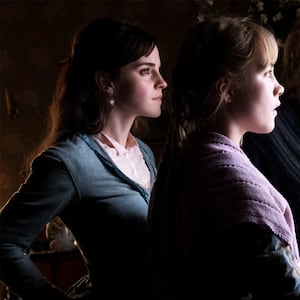Jacqueline Durran, who designed the costumes in Greta Gerwig’s Little Women, has been nominated for seven Academy Awards. (She won one, for 2012’s Anna Karenina.) When news broke Monday morning that she had garnered yet another accolade, Durran was, in her words, “quite literally” at work in London, on the set of Matt Reeves’ The Batman.
“I was walking back from the canteen,” Durran told The Daily Beast. “I didn’t have my phone, but someone walked by and said congratulations. I missed it somehow.”
Despite her track record, Durran said that “it’s always a surprise” to hear the news. “I immediately wanted to know how Little Women had done overall,” she explained. “It was very collaborative, so I wanted to know who else had been recognized, and I wanted to be happy for everyone.”
ADVERTISEMENT
Of course, there’s much for the Little Women crew to be happy with—the film is up for Best Picture and Adapted Screenplay, with Saoirse Ronan and Florence Pugh earning acting nominations as well. But Greta Gerwig failed to nab the directing nomination many believe she earned, and was cast out of an all-male field. As Issa Rae said after John Cho announced the line-up, “Congratulations to those men.”
“It’s a shame for me that she’s not nominated,” Durran said of Gerwig. “I feel very sad that she didn’t get it. I think she made a great film that’s also very successful and touches a lot of people. I’ve had more people contacting me having been to see this movie, talking about how much they loved it, more than almost any other film I’ve worked on.”
Still, the British designer is decidedly diplomatic when it comes to addressing the snub. “It’s unfortunate that the category is so full this year of industry greats,” Durran said. “If anyone asks who shouldn’t be there, I don’t know [the answer]. It’s just one of those things. There’s not enough space.”
Durran spent time on Monday afternoon “thinking” about the Gerwig exclusion. She doesn’t want to cry sexism or misogyny because she “doesn’t know” the Academy voter demographic. “They’ve massively increased the voting community, possibly doubled its size since I’ve joined around 15 years ago,” Durran explained. “I can’t say it’s gendered voting because I just don’t know. I don’t know the answer. But I hope it isn’t.”
Durran, 53, got the Little Women gig after speaking with Gerwig and re-reading the book, which she “devoured” as a child. Unlike past adaptations, Gerwig blends the story of the March family characters with their real-life counterparts, the book’s author Louisa May Alcott and her relatives.
“Greta was very interested in the radical life Alcott lived in Massachusetts, and how alternative [her family] was for their time,” Durran said. Gerwig visited London, where the two pulled inspiration and dug through historical archives.
“We looked for references—art, 1860s photography, looking for people who were outside of the main Victorian life because they were artists,” she explained. “[We wanted to find pictures of] people who didn’t look the way you expected Victorians to look, people who were outside of the mainstream as a way of getting into what the Alcotts looked like.”
Gerwig decreed that each March sister would have their own color scheme, a notion she pulled from a scene in the novel where their mother, Marmee, gives each girl a differently-hued notebook on Christmas morning. But nothing was dogma.
“Jo’s was red, Meg’s was green, Beth’s color was pink or brown, and Amy’s was light blue,” Durran said. “But we didn’t really want to put an actress in green over and over again, so I made color combinations. I didn’t want to be prescriptive, so I played around, a bit of this color, a bit of that.”
The costumes of the March sisters are bright—acidic, even—and the clothes stand out against the dreary Concord, Massachusetts backdrop, where it is seemingly always winter. In one scene where the four Little Women are walking down the street together, Meg (Emma Watson) wears a lime green checkered scarf, a nearly-neon pop that wouldn’t be out of place on a twentysomething today.

Durran said that Victorian clothes could get “quite bright and bold,” especially after the introduction of synthetic aniline dyes in the mid-1850s. It’s not hard to imagine that a family made up of an aspiring writer (Jo), thespian (Meg), painter (Amy), and musician (Beth) wouldn't be above a little bit of sartorial peacocking, anyway.
The end result is era-accurate, sort of, but enough of a visual treat to shut up anyone concerned with exactness. Would Marmee, played by Laura Dern, really wear epic paisley and trumpet sleeves for a day spent chasing around schoolchildren? Probably not, but you won’t see too many people complaining about her opulent outfits.
“I think the most important thing is to capture and represent the spirit and the characters of the girls,” Durran said. “That’s what Greta was searching for, so that’s your primary responsibility. For me, it was a mixture of true period and mixed period.”
That’s why Jo doesn’t wear a corset, which would have been standard issue in the 1860s. “It just didn’t feel right for Saoirse [Ronan],” Durran explained. “So we decided that Jo wasn’t a corset wearer. And there were probably real Victorians who didn’t wear corsets—Louisa May Alcott would go on runs, and I don’t believe that she ran in a corset and heavy petticoats.”
It’s easy to come at Gerwig’s film with a modern perspective, trying to force a gender-blurring narrative out of the fact that Jo and Laurie (Timothée Chalamet) share clothes at certain points of the film. Durran isn’t quite as esoteric.
“I thought of it from a natural point of view,” she said. “I imagined the two of them meeting when they were in their late teens, Jo not wanting to be a girl, Laurie quite interested in girls, and the whole symbiotic nature of their friendship would lead you to think that if Jo wanted to wear boys’ clothes, she would wear his waistcoat.”
Though Durran traded her (lack of) corsets for catsuits with her foray into superhero dressing, she believes she’ll be back to period pieces soon. “I like the freedom that you get with them, the freedom of interpretation,” she said. “You have less of that in modern pieces, because everyone is conscious of what modern clothes mean. With period, you’re always finding things that approximate the past, and I find it enjoyable to recreate something when it no longer exists.”
So now Durran, a truly busy person, faces yet another task: finding out what to wear to this year’s Oscars. “I need to think about it for a second,” she said. “That’s a new stress. Maybe I can go out and buy something, but I don’t normally.”

Costume designer Jacqueline Durran, winner of the Best Costume Design award for “Anna Karenina,” poses in the press room during the Oscars on Feb. 24, 2013, in Hollywood, California.
Jason Merritt/GettyShe made the denim coat dress she wore to the podium to collect her Oscar in 2013, which she layered over three-quarter trousers (and borrowed Chanel diamonds). “I quite liked it, but the best dress I had was a time I didn’t win,” Durran recalled. “I made a plain dress, and I got someone to draw all over it. But no one ever saw that one.”







